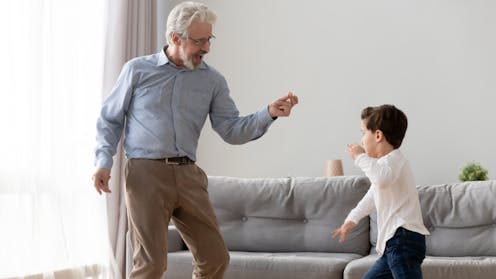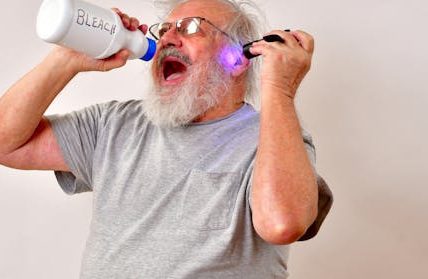Getting young and old people to dance together boosts health and reduces age discrimination – new research
As the global population ages, the number of people aged 65 and older is projected to rise significantly over the next 25 years. But while we’re living longer, we’re also becoming more socially divided by age. Age segregation is on the rise and fewer people are regularly interacting with those outside their own generation.
This growing divide can fuel ageism – a form of discrimination that’s more widespread than many realise. Around half of the global population have experienced ageism at some point in their lives. Not only is this socially damaging, it’s also linked to poorer health outcomes and increased healthcare costs.
We know that regular physical activity is vital for our physical and mental wellbeing across all age groups. Yet many teenagers and older adults are falling short of recommended activity levels.
For adults, staying active helps prevent and manage chronic conditions like heart disease, cancer and type 2 diabetes. For children and teens, it supports healthy growth and development.
Dance is more than just movement – it’s creativity, self-expression and social connection. As a form of physical activity, it offers a wide range of benefits at all stages of life. For children, dance supports developmental maturity, attention span and memory. For adults, it can improve balance, flexibility, body composition and coordination.
Intergenerational dance takes this a step further, bringing people of different ages together in a shared creative space. It’s a form of social and artistic exercise that promotes health, strengthens community bonds, and helps challenge stereotypes about ageing.
Our research team is now designing and evaluating an intergenerational dance programme for teenagers and older adults in Ireland, to explore the extent to which shared movement can improve physical and mental health – and foster stronger connections between generations.
To inform the design, we reviewed intergenerational dance initiatives around the world. While a few programmes had been formally evaluated, most had not explored the health outcomes or participant experiences in depth. Where evaluations did exist, results were positive: participants of all ages found the experience enjoyable and appreciated the opportunity to connect with people from other generations.
Building on this, we ran a pilot programme in a local community centre, held after school hours. Sessions were co-led by a professional dance instructor and a physiotherapist trained in intergenerational practice. Each session followed a consistent structure:
icebreaker games like “human bingo”
warm-up
mirrored movement exercises
social partner dancing
cool-down
refreshments and informal socialising.
Our participants – adults aged 60+ and adolescents aged 14-16 – provided feedback throughout the pilot. For many, it was their first experience of interacting socially with people outside their own age group – and the response was overwhelmingly positive.
Before and after the programme, participants completed assessments measuring physical activity, cognitive function and emotional wellbeing. The results showed a reduction in sedentary behaviour among older adults and improved cognitive performance in both age groups. These early findings suggest that intergenerational dance may offer measurable benefits for both brain and body.
This was the first study to use objective measures of physical activity in an intergenerational setting – previous research has largely relied on qualitative feedback. While objective data on activity levels have been collected separately in adolescents and older adults, our study is the first to apply this approach across generations participating together.
It’s about more than just movement
Building on this, the next phase of the project introduces a new home-based component. Between sessions, participants are encouraged to complete short dance-based exercises at home. This element is designed to reinforce regular movement and promote sustained physical activity throughout the week.
The refined ten-week programme is now being rolled out across secondary schools in the mid-west of Ireland, for fourth-year pupils aged 15-16 and adults aged 60+. Each session increases in intensity, while being tailored to the evolving needs and abilities of those taking part.
To assess the impact, researchers will track physical activity via participants’ wearable devices, evaluate their balance, mobility and cognition, and use questionnaires to measure their moods, wellbeing and attitudes toward ageing.
Our aim is to determine whether embedding an intergenerational dance programme into the school year is not only feasible and enjoyable, but capable of delivering measurable health and social benefits at scale.
This project offers a rare and powerful opportunity for older adults and teenagers to move, laugh and learn together. If successful, it could pave the way for the wider adoption of intergenerational dance initiatives across Ireland and beyond.
At its heart, this project is about more than movement. By creating space for shared experience and physical expression, we may not only improve health but help mend the widening gap between generations – contributing to a society that moves more, and divides less.
Siobhán O’Reilly receives funding from Taighde Éireann – Research Ireland.
Amanda Clifford received funding from the Health Research Board for Definitive Intervention and Feasibility Awards (2020), and the Music and Movement for Health research study.
Orfhlaith Ni Bhriain received funding from the Health Research Board in 2020 under the Definitive Interventions and Feasibility Awards scheme. She was a co-applicant in the Music and Movement for Health research study.



